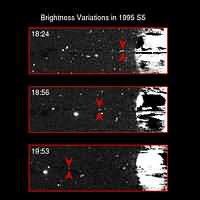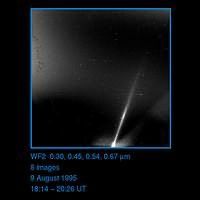1 min read
Reappearance of Saturn’s Satellite Mimas

On 10 August 1995 HST observed the second passage of the Earth through Saturn's ring plane in the 1995/96 series of triple crossings. This pair of 100 sec exposures was taken with the Wide Field and Planetary Camera (WFPC2) in planetary (high resolution) mode 2.5 hours prior to the Earth's passage through the ring plane. An 8922 A methane band filter was used to reduce the scattered light from the planet.
The rings appear as a razor-thin line extending from the planet's eastern limb out to the usually faint F Ring, at a radius of 140,000 km. Unlike ground-based images taken a few days earlier, the rings show no sign of clumps or bright spots at this time. The brightness of the rings in this view implies an effective `thickness' of about 1.5 km, although the actual ring thickness is much less than this - probably as little as 10 meters. The edge-on brightness of the rings is due to a combination of vertical waves in the rings, the F Ring, and perhaps other unidentified sources.
In August, the sun was 1.5 degrees above (ie., on the north side of) the ring plane. In the first image, the satellite Mimas is seen very faintly approximately 0.8 arcsec below the rings, in the shadow of the almost opaque B Ring. Three minutes later Mimas has brightened considerably as it is illuminated by sunlight shining through the relatively transparent Cassini Division between the A and B Rings. Epimetheus, the smaller of the two co-orbital satellites, is visible just above the ring plane and 0.6 arcsec from the eastern ansa.
- Object NameObject NameA name or catalog number that astronomers use to identify an astronomical object.Saturn, Mimas
- Release DateAugust 11, 1995
- Science ReleaseHubble Again Views Saturn’s Rings Edge-On
- Credit
Related Images & Videos

Saturn's Rings Edge-on
Saturn's magnificent ring system is seen tilted edge-on - for the second time this year - in this NASA Hubble Space Telescope picture taken on August 10, 1995, when the planet was 895 million miles (1,440 million kilometers) away. Hubble snapped the image as Earth sped back...

Motion of Saturn's Satellites
This sequence of 100 sec exposures taken with HST's Wide Field and Planetary Camera (WFPC2) in planetary mode on 10 August 1995 shows three of the smaller satellites of Saturn, as well as the newly discovered object 1995S5. Epimetheus is the smaller co-orbital satellite and...

Brightness Variations in Saturn's Satellite 1995S5
This sequence of 100 sec exposures taken with HST's Wide Field and Planetary Camera (WFPC2) in planetary mode on 10 August 1995 shows the newly discovered object 1995S5 (red arrows) moving in its orbit around the planet. As it moves further from Saturn, its brightness decreases...

Saturn's E Ring in Ultraviolet Light
Visible from Earth only at times of ring plane crossing, Saturn's tenuous E Ring was discovered during the 1966 crossings and imaged again in 1980. From these observations, its color is known to be distinctively blue. The E Ring was captured in ultraviolet light for the first...
Share
Details
Claire Andreoli
NASA’s Goddard Space Flight Center
Greenbelt, Maryland
claire.andreoli@nasa.gov






























